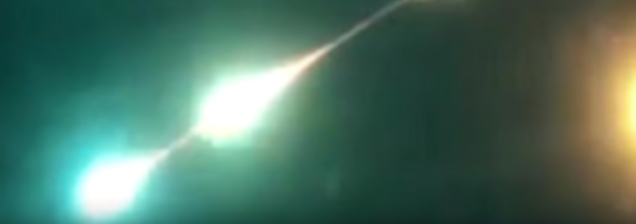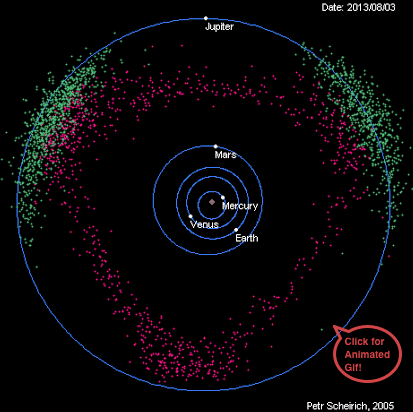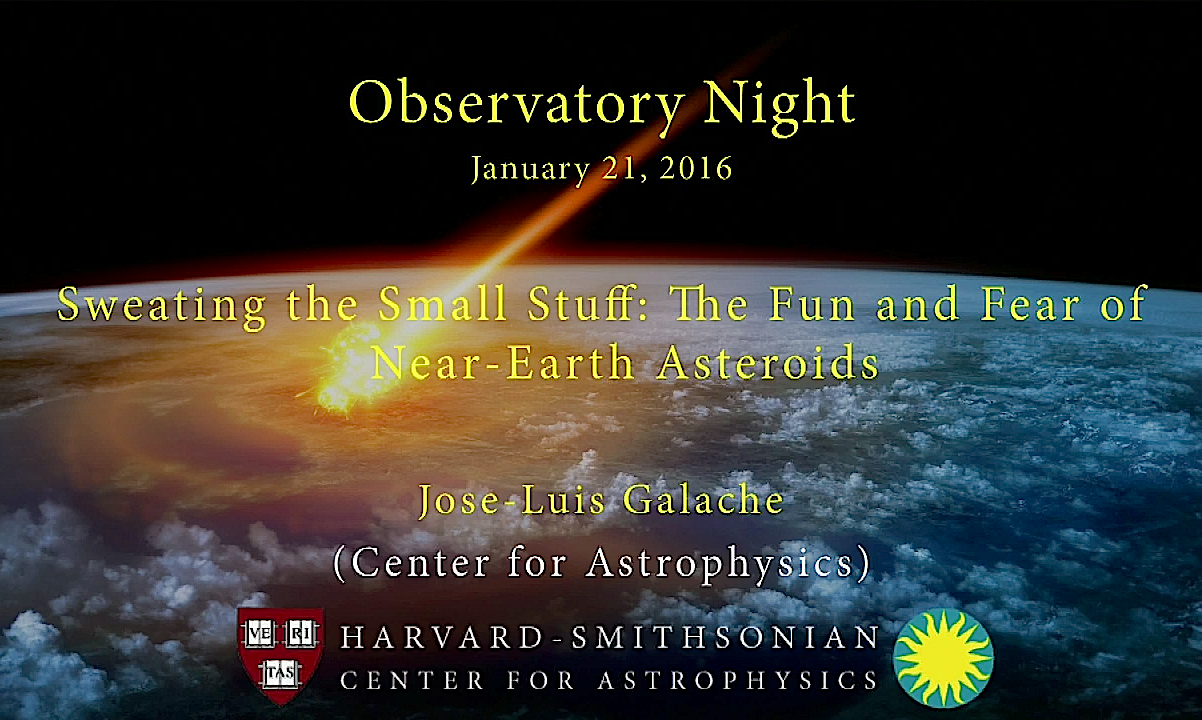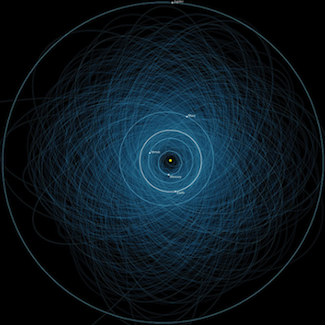 April 2016 April 2016 | Asteroid
Designation | Type | Flyby Date
Univ. Time | × Lunar
Distance | Diameter
In Meters | | 2016 ED157 | Amor | 1 − 13:07 | 47.66 | 34- 82 | | 2008 FX6 | Aten | 3 − 7:51 | 22.74 | 27- 59 | | 2012 TS | (420738) Aten | − 23:22 | 48.08 | 183- 411 | | 2002 AJ29• | (141354) Amor | 6 − :41 | 55.16 | •921-2100 | | 2016 EV27 | Apollo | − 18:12 | 14.62 | 72- 162 | | 2016 EZ26 | Apollo | 7 − 1:52 | 40.02 | 81- 182 | | 2002 EB3• | (208617) Apollo | 8 − 18:27 | 55.58 | •770-1714 | | 2016 EF85 | Amor | − 22:36 | 32.65 | 25- 62 | | 2016 DP•h | Apollo | − 23:55 | 55.03 | •301- 674 | | 2008 GU20 | Amor | 9 − 11:29 | 57.14 | 64- 142 | | 1998 HD14 h | (437841) Aten | − 15:26 | 60.32 | 180- 392 | | 2008 GG2 | (330659) Amor | 10 − 4:03 | 56.34 | 77- 171 | | 2016 ED158 | Apollo | − 12:52 | 26.89 | 74- 180 | | 2016 EH157 h | Apollo | − 18:02 | 25.92 | 181- 405 | | 2009 KJ• | (406952) Apollo | − 18:46 | 37.68 | •1010-2300 | | 2004 FG11 h | (363599) Apollo | 11 − 16:39 | 19.29 | 170- 380 | | 2009 BC11 | Apollo | − 19:04 | 31.51 | 97- 220 | | 2012 SW20•h | Apollo | − 21:52 | 44.32 | •310- 682 | | 2005 GR33 | Aten | 13 − 3:27 | 7.66 | 110- 240 | | 2016 EK27 | Apollo | − 20:19 | 21.03 | 98- 220 | | 2008 HU4 | Apollo | 16 − 10:00 | 4.59 | 6- 14 | | 2016 AO165• | Apollo | − 20:22 | 48.04 | •271- 610 | | 2012 EA | Apollo | − 22:09 | 53.08 | 11- 25 | | 2014 HJ4 | Amor | 19 − 21:54 | 53.91 | 56- 124 | | 2014 QS295 | Apollo | 21 − 7:15 | 53.93 | 110- 250 | | 2014 UR | Aten | 23 − 3:30 | 30.77 | 13- 28 | | ♦ 2nd Pass (Oct 18) − 3:49 | 11.96 | | | 2016 BU13• | Apollo | − 10:38 | 30.51 | •280- 620 | | 2006 HF6 | Apollo | − 10:43 | 35.55 | 35- 78 | | 2003 KO2 h | Aten | 25 − :21 | 17.89 | 242- 542 | | 2013 UE3 | Apollo | − 6:03 | 65.34 | 76- 171 | | ♦ 2nd Pass (Jul 21) − 14:07 | 73.70 | | | 2001 BB16 | Aten | 28 − 3:44 | 71.78 | 63- 142 | | 2013 KJ6• | Aten | − 8:57 | 36.87 | •291- 651 | | ♦ 2nd Pass (Sep 17) − 5:38 | 113.97 | | | 2001 VG5• | (194386) Apollo | − 22:29 | 52.41 | •1108-2477 | | 2002 CX58 h | Apollo | 29 − 9:01 | 16.54 | 101- 225 | | 2015 VB1 | Aten | − 22:01 | 61.62 | 50- 113 | | ♦ 2nd Pass (Nov 17) − 4:09 | 62.44 | | | 2008 PR9 | Aten | 30 − 6:36 | 8.74 | 88- 196 | | 2014 WU200 | Apollo | − 8:28 | 52.05 | 4- 8 |
Data also compiled from the Minor Planet Center’s G+ posting updates.
Outer Solar System Asteroids | |  May 2016 May 2016 | Asteroid
Designation | Type | Flyby Date
Univ. Time | × Lunar
Distance | Diameter
In Meters | | 2014 US115 | Apollo | 1 − 1:55 | 7.42 | 31- 71 | | 2013 WT45 h | Apollo | 2 − 14:22 | 58.19 | 242- 542 | | 2006 UK h | (444584) Apollo | 3 − 15:44 | 17.81 | 253- 567 | | 2015 VF150 | Apollo | − 19:14 | 42.85 | 21- 47 | | 2008 TZ3 h | (388945) Apollo | 5 − 10:39 | 13.13 | 221- 494 | | 2014 US56 | Apollo | − 20:31 | 53.45 | 15- 34 | | 2014 JG55• | Apollo | 8 − :32 | •.82 | 3- 8 | | 2015 VU64 | Aten | − 5:19 | 60.03 | 2- 4 | | 2010 KP10 | Apollo | − 16:20 | 29.45 | 58- 130 | | 2005 XB1 | Apollo | 9 − 3:57 | 77.15 | 105- 236 | | 1999 VR6 h | Apollo | 10 − 20:10 | 72.28 | 183- 411 | | 2015 YK | Apollo | 12 − 10:59 | 42.06 | 17- 39 | | 2014 BM62 | Apollo | − 11:56 | 45.98 | 23- 51 | | ♦ 2nd Pass (Jul 18) − 1:10 | 19.19 | | | 2008 GC110 | Apollo | 13 − 4:47 | 68.63 | 96- 215 | | ♦ 2nd Pass (Sep 10) − 7:09 | 80.69 | | | 2007 VT6 h | Apollo | − 5:47 | 48.29 | 231- 517 | | 2015 HZ176 | Aten | − 14:01 | 63.50 | 48- 108 | | 2007 CN26 h | (371660) Apollo | 14 − 17:06 | 68.51 | 160- 358 | | Selqet •♠ | (136818) Aten | 15 − 13:44 | 44.05 | •402- 899 | | 2014 MS67 | Apollo | 16 − 11:13 | 46.77 | 152- 342 | | 2016 BX14 | Apollo | − 18:17 | 22.56 | 196- 439 | | 2006 XX2 | Aten | 18 − 7:50 | 62.93 | 25- 56 | | 2015 VO142 | Apollo | − 11:58 | 54.86 | 4- 9 | | 2000 AF205 h | Apollo | − 12:58 | 71.12 | 121- 271 | | 2005 UU3 | Apollo | − 20:19 | 65.88 | 105- 236 | | 2014 GC49 | Aten | 19 − 7:23 | 62.78 | 5- 11 | | 2012 VU76 | Apollo | 20 − 2:40 | 42.93 | 19- 43 | | 2016 CF194 | Amor | 24 − 13:35 | 15.62 | 37- 83 | | 2009 DL46 h | Apollo | − 17:59 | 6.16 | 127- 284 | | 2004 JX20• | Aten | 26 − 1:39 | 56.93 | •350- 783 | | ♦ 2nd Pass (Nov 16) − 8:27 | 123.69 | | | 2002 LT24 h | Aten | − 3:21 | 39.36 | 101- 225 | | ♦ 2nd Pass (Sep 29) − 5:03 | 186.38 | | | 2011 GP44 | Aten | − 6:05 | 48.13 | 35- 78 | | 2015 KT120 | Aten | − 19:19 | 57.12 | 26- 59 | | 2014 WE6 | Aten | 30 − 3:57 | 54.38 | 2- 5 | | 2010 LL68 | Apollo | 31 − 15:01 | 67.28 | 69- 156 | | 2015 YU1 | Apollo | − 19:50 | 28.06 | 30- 68 | | 2009 HD82 | Apollo | − 22:18 | 60.68 | 127- 284 |
Data also compiled from the Minor Planet Center’s G+ posting updates.
Jupiter’s Trojan(green) & Hilda(red) Asteroids
Check Out This Video by The Minor Planet Center : | |  June 2016 June 2016 | Asteroid
Designation | Type | Flyby Date
Univ. Time | × Lunar
Distance | Diameter
In Meters | | 2004 KH17 h | Aten | 2 − :18 | 44.22 | 110- 247 | | 2006 XE2 | Apollo | 5 − 8:46 | 37.02 | 105- 236 | | 2006 JF42•h | Aten | 6 − 10:52 | 35.79 | •402- 899 | | 2009 KR4 | Aten | 9 − 7:15 | 24.65 | 26- 59 | | 1997 XF11•h | (35396) Apollo | 10 − 16:12 | 70.04 | •1108-2477 | | 2009 MW | Aten | 12 − 4:09 | 44.77 | 192- 430 | | 2002 LY1 h | Aten | − 8:08 | 19.85 | 101- 225 | | 2015 XZ378 | Apollo | 13 − 4:38 | 9.67 | 8- 19 | | 2015 KS120 | Aten | − 23:18 | 55.77 | 22- 49 | | ♦ 2nd Pass (Nov 2) − 3:45 | 46.95 | | | 2009 ME9 | Aten | 14 − 11:31 | 64.06 | 146- 326 | | 2007 MK6•♠ | Apollo | 15 − 7:39 | 39.63 | •278- 622 | | 2003 GY h | (382758) Apollo | − 17:34 | 30.85 | 242- 542 | | 2002 LT38 h | Aten | 16 − 3:17 | 27.12 | 231- 517 | | 2013 BO27 | Apollo | − 18:04 | 19.82 | 42- 94 | | 2015 KF | Aten | 17 − 20:00 | 51.78 | 25- 57 | | 2009 CV | Apollo | 20 − 1:31 | 12.40 | 36- 82 | | 2013 ND15 | Aten | 21 − 17:32 | 24.59 | 40- 89 | | 2016 CV193 | Apollo | 23 − 23:49 | 50.15 | 75- 169 | | 2010 NY65 h | (441987) Aten | 24 − 10:30 | 10.71 | 133- 297 | | 2012 BD14 | Apollo | 26 − 8:45 | 76.13 | 13- 29 | | ♦ 2nd Pass (Sep 24) − 15:13 | 79.19 | | | 2011 FC29 | Apollo | 27 − 3:00 | 44.84 | 175- 392 | | 2007 WU3 | Apollo | 28 − 14:32 | 44.63 | 46- 103 | | 2014 KM22 | Amor | 30 − 21:31 | 45.60 | 13- 29 |
Data also compiled from the Minor Planet Center’s G+ posting updates.
Mouse over this if you think we won’t get hit, eh?

[Notice the Earth’s orbit is in the densest part of the asteroids’ orbits!]
[Note: New 2016 NEO orbital tracks are not included in above image.]
NEOs (Near Earth Objects), or NEAs (Near Earth Asteroids),
are also referred to as AAAs. - There are more than 200,000: | | 32% | Amor-asteroid orbits approach but do not cross Earth’s.
Amors orbit farther from the Sun than Earth and many remain entirely between Earth & Mars. | | 62% | Apollo asteroids’ wider orbits cross Earth’s and spend more time outside Earth’s orbit. | | 6% | Aten asteroids’ orbits cross Earth’s but spend more time inside Earth’s orbit and are more difficult to detect. | | <1% | Atira asteroids’ orbits remain entirely inside Earth’s orbit (aka: Interior Earth Objects or IEOs). | | <1% | Comets have highly elliptical,+ hyperbolic orbits and
can also pass near or impact Earth. - Some speed in+ from beyond Pluto with most not in the ecliptic.+ | PHAs* NASA+: “Potentially Hazardous Asteroids (PHAs,
1648 known) are currently defined based on parameters that measure the asteroid’s potential to make threatening, close approaches to the Earth. Specifically, all asteroids with an Earth Minimum Orbit Intersection Distance (MOID) of .05 AU [Astronomical Unit: mean distance from Earth to Sun] or less and an absolute magnitude (H) of 22 or less are considered PHAs. In other words, asteroids that can’t get any closer to the Earth (i.e., MOID) than .05 AU (roughly 7,480,000km
or 4,650,000miles) or are smaller than about 150m (500ft) in diameter (i.e., H=22 with assumed albedo+ of 13%) are not considered PHAs.
This “potential” [for] close Earth approaches does not mean a PHA will impact the Earth. It only means there is a possibility for such a threat. By monitoring these PHAs and updating their orbits as new observations become available, we can better predict the close-approach statistics and thus their Earth-impact threat.” – After Chelyabinsk,+ I’m not so sure about that at all !!!
Just so you understand, let me explain why NASA uses the term *PHA (Potentially Hazardous Asteroid). - You see, if an asteroid comes close enough, Earth’s gravity will affect its trajectory for the next time it passes, possibly causing an impact. - Personally, I don’t believe for one nanosecond that if NASA finds one which has an impact trajectory that they’ll tell us about it, unless it’s small enough not to be a problem otherwise. - So, keep checking in here for any “trends,” eh? - •I would!• - [Note: Above 2nd Qtr. LDs are minimums.]
[Author’s Note: Data compiled above is from four sources, so I intentionally err on the side of caution. For example, if one source has an earlier time of closest approach, that one is used. Similarly, if one source has a larger size or size range, that one is used above as well. The same goes for distance
at passage, the lesser datum is used, especially because in
one case or another the Lunar Distance standard used varies slightly. I figured diameters from absolute magnitude (H), with reflectance/albedo from .25 to .05 which, again, varies from one source to another. - (I also figured  LDs.)] LDs.)]
International/uS ©Copyright 2016 by RK (aka: MayarOwl) |
|



